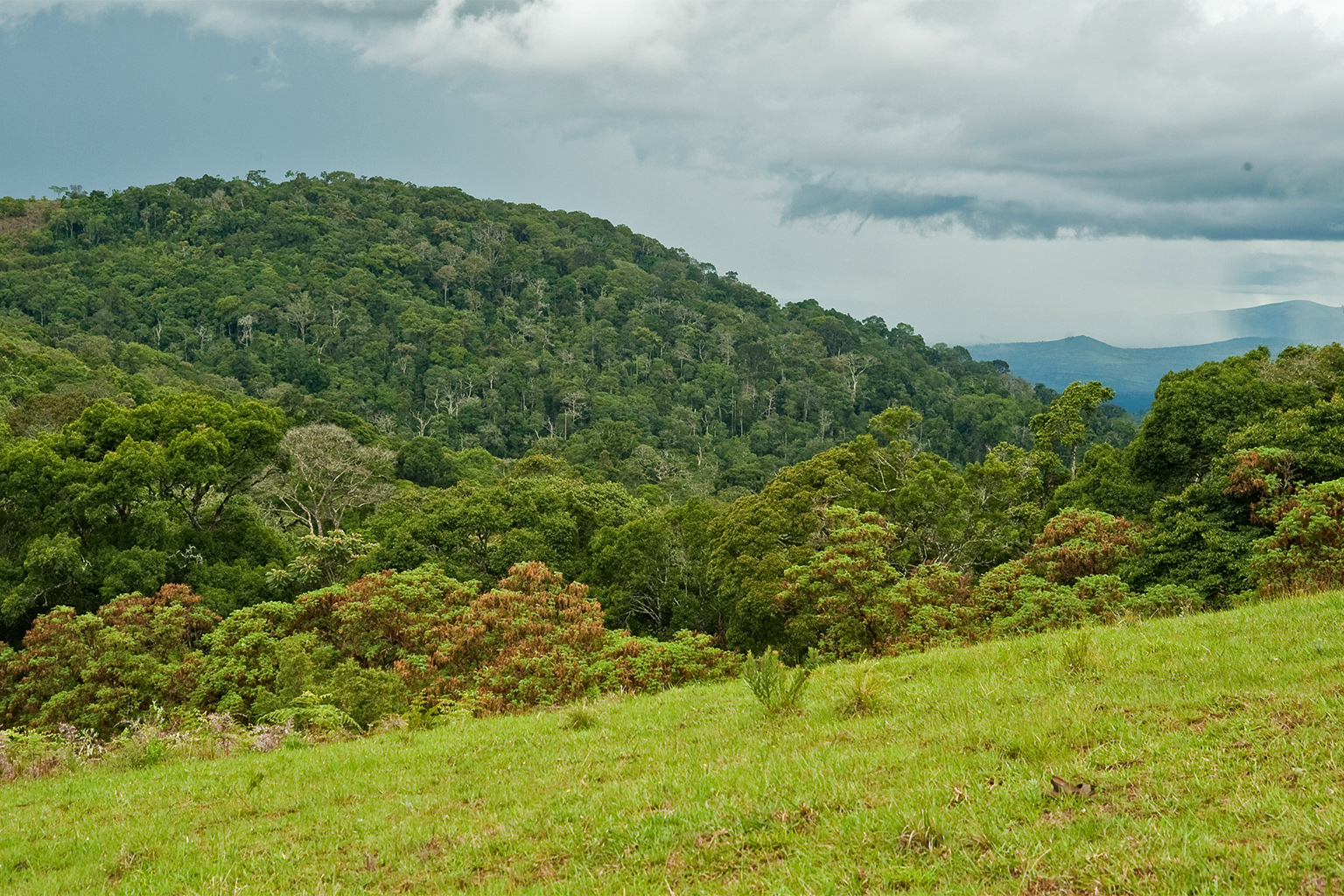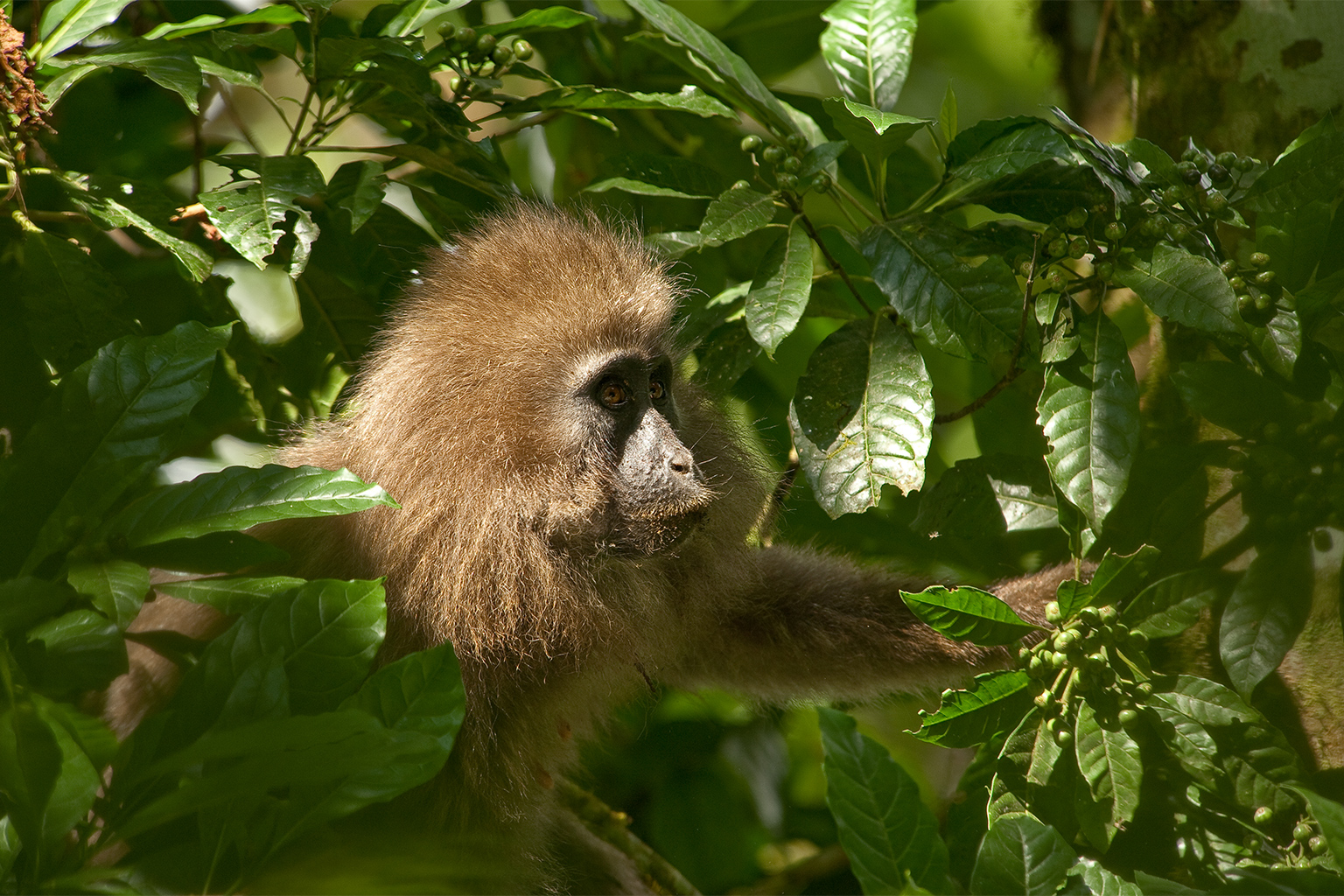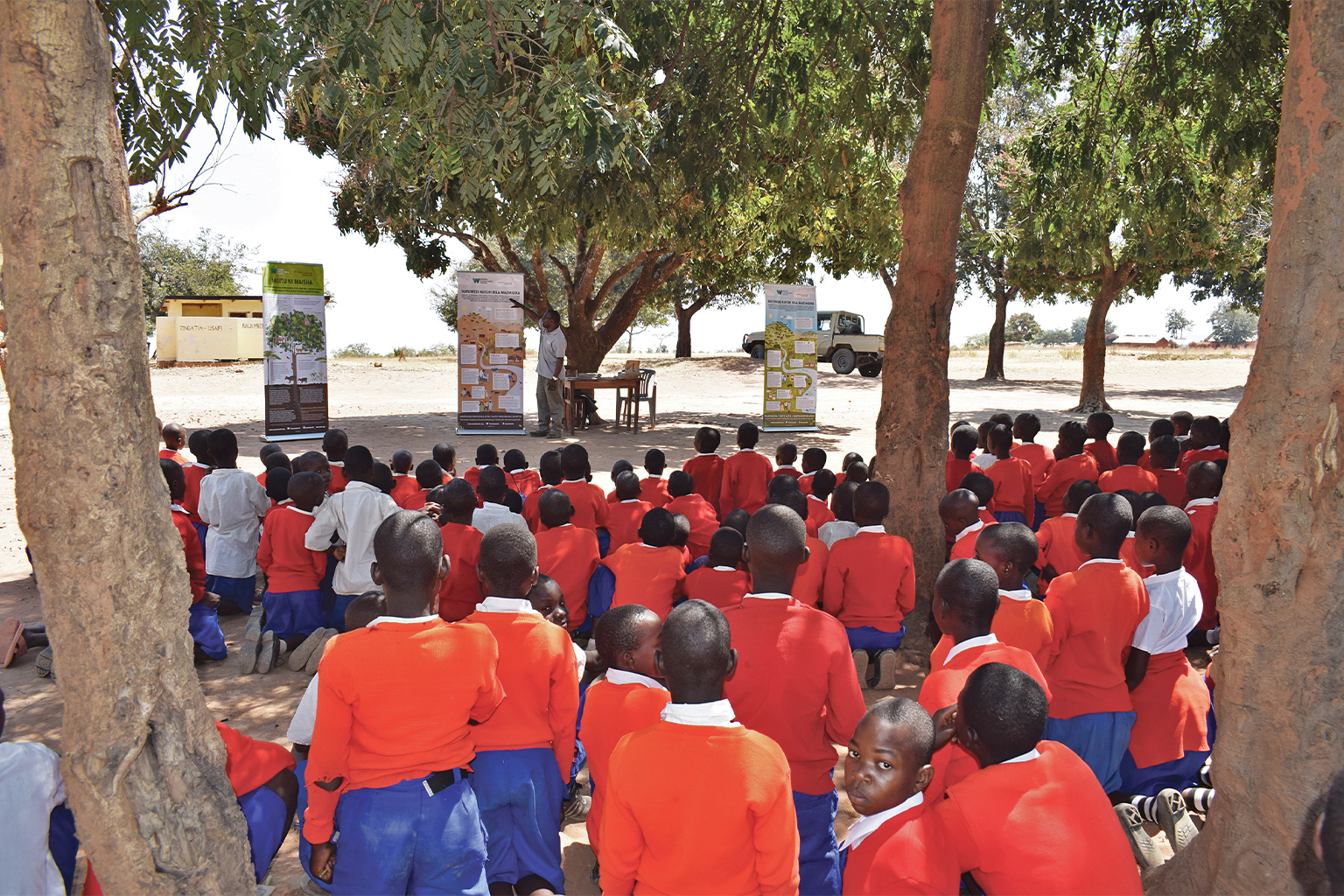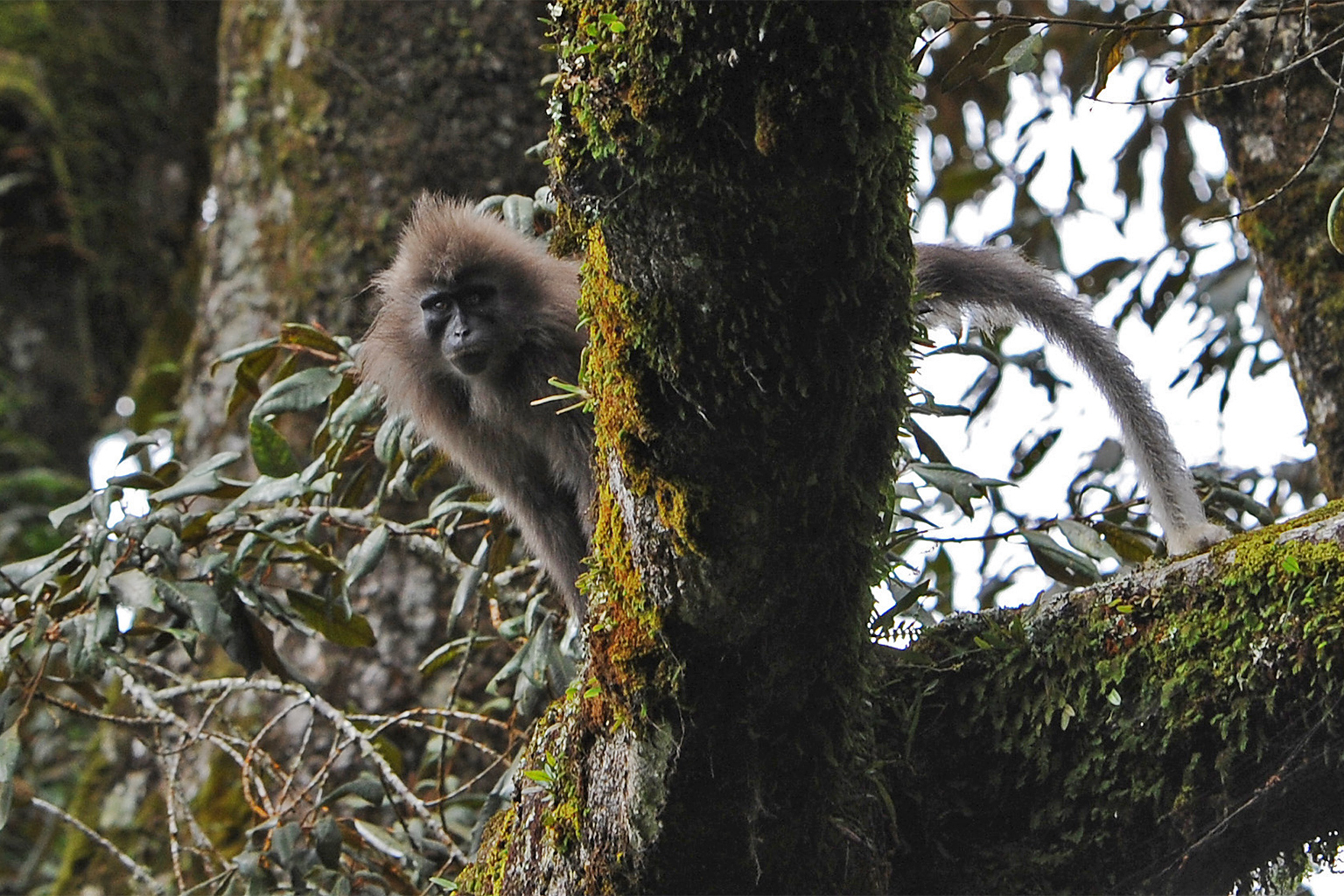- A recent census shows that the population of the kipunji monkey (Rungwecebus kipunji) in Tanzania’s Southern Highlands has increased by 65%, while signs of human impacts in its habitat decreased by 81%, over a 13-year period.
- The increase follows 20 years of intensive holistic conservation efforts by the Wildlife Conservation Society and Tanzanian government partners, including greater legal protection for forests and community engagement.
- The total population size of the kipunji is estimated at 1,966 individuals in two subpopulations, and the species is classified by the IUCN as endangered.
- The kipunji has been on the Primates in Peril list of 25 most endangered primates three times: in 2006-2008, 2008-2010, and 2018-2020, but was not on the most recent list.
In January 2003, when Wildlife Conservation Society researchers working in Tanzania’s Southern Highlands heard from local hunters that there was a monkey called the kipunji living on the slopes of Mount Rungwe, they didn’t know what to think. They had never heard of the kipunji, but the local Wanyakyusa are storytellers, and the line between the real and mythical is often blurred.
Then, in May that year, while doing biodiversity surveys in the Southern Highlands, the researchers caught their first glimpse of a strange primate. It took many months of trekking through the steep forested slopes on the heels of these elusive monkeys before they got a good look. Only then could they confirm that the kipunji — with its light-brown tufted triangular crest, black face, a muzzle similar to a baboon’s, and a loud honking call — was a species new to Western science.
In a strange coincidence, in July 2004, researchers working in Tanzania’s Udzungwa Mountains some 350 kilometers (220 miles) to the northeast, also discovered what they believed was a new primate. In 2005, the two teams jointly published a paper in the journal Science describing the new species. They initially dubbed it the highland mangabey (Lophocepus kipunji), but later, following genetic analysis of a dead specimen, they renamed it the kipunji (Rungwecebus kipunji), putting it into its own genus, meaning it wasn’t closely related to any other monkey. This made the kipunji the first new primate genus described in Africa in more than 80 years.

But with excitement of the new discovery came deep concern. The kipunji and its forest habitat, rich in biodiversity and endemic species found nowhere else, were in trouble. The Mt. Rungwe and Livingstone Range Forest in the Southern Highlands, home to nearly 95% of the kipunji population, wasn’t in a national park; tree felling, charcoal making and poaching were common. Farms pushed right up against the forest’s edge, threatening to sever the ecosystem and isolate kipunji groups. In the Udzungwa Mountains, where scientists uncovered the second kipunji population, the forest was in better condition — but the kipunji population there was very small. The first census, done in 2007, put the total kipunji population, at both sites combined, at just 1,117 individuals.
“Of course, the monkey [discovery] was very exciting — but it was also very useful,” says Tim Davenport, formerly director of species conservation and science for Africa at WCS, and now Africa director for Re:wild. The discovery drew international attention, garnered political support and attracted funding, allowing WCS to work with government and community partners to implement a holistic long-term conservation program.
The program worked. The latest census showed that over the past 13 years, the kipunji population in the Southern Highlands increased by 65% and expanded its range by nearly one-fifth, while signs of human disturbances dropped by 81%, according to a 2022 International Journal of Primatology paper.


Davenport says little was known about the biodiversity of the Southern Highlands when WCS began working there in 1999. The area doesn’t have the big game of Tanzania’s northern parks like the Serengeti, nor, at the time, the reputation of a biodiversity hotspot like the Udzungwa Mountains. But the area did have an intriguing montane-grassland mosaic, rich volcanic soils and ample rainfall — a breeding ground for biodiversity waiting to be discovered.
But finding a rare monkey in a montane forest isn’t so easy. Sophy Machaga first joined WCS in 2003 and is now the organization’s Southern Highlands conservation project director. She recalls those early days when the team would trek for hours on the steep, thickly forested slopes, riven with gullies, searching for the elusive kipunji.
“You don’t see it, and then when you see it, it runs away,” she says. “Sometimes when you find it, you follow it for a few hours and after that it will just jump to the other ridge. But you can’t jump to the other side, you have to go all the way down and follow the other ridge … and then you’ve lost it.”
Slowly, though, the team built up an understanding of the kipunji’s basic biology. The monkeys live in montane forests at altitudes of 1,300-2,450 meters (4,270-8,040 feet), in groups of 15 to 30 individuals. They mostly stay in the tree canopy, feeding on a wide variety of leaves, bark, fruit, seeds and invertebrates.

Though the behavioral questions were fascinating, Davenport says the research focus was always on applied studies to aid conservation. That included looking at human-wildlife conflict.
Farmers in the Mt. Rungwe–Livingstone area grow bananas, maize, potatoes and occasionally horticultural crops like carrots. Though generally shy, kipunji will loiter at the forest edge and opportunistically raid crops. In response, farmers lay crude but lethal log traps.
Machaga describes how she witnessed crop-raiding when she was doing some observations in the Rungwe area to try to understand the extent of the problem. There was a farm near the forest, and in the center of the farm, a hut where the farmer had hung some bundles of maize to dry. When the farmer left the farm, a juvenile male kipunji scampered to the top of one of the trees at the forest edge and surveyed the area. Seeing no-one, he let out a call.
 Villages in the Southern Highland largely depend on firewood for cooking. Overall, signs of human activities in kipunji habitat fell by 81% overall over 13 years, following a holistic conservation program. Signs of tree felling – like this saw pit – and charcoal-making virtually disappeared in the Mt. Rungwe and Livingstone areas where kipunji are found. Image courtesy of Tim Davenport. |
“Then imagine,” Machaga says, “like 30 monkeys coming from the forest. The females and children were just by the forest edge and the subadults were running to that hut, opening it, passing the maize to the females, then running back to the hut to take more … I thought, my god, that man … we will have to at least offer some compensation.”
To mitigate the conflict, the WCS team tried out a number of deterrents; smearing chili oil and cow dung paste on the maize stalks at the entrance of the field worked best. Farmers also changed cropping patterns, planting avocados or potatoes, which the monkeys don’t seem to like as much, in fields closer to the forest.
Other obvious threats to kipunji were habitat degradation, caused by tree felling for timber and charcoal making, and snares set by hunters in the forest. Tackling those requires aligning “sticks and carrots,” says Davenport, so that there’s an overall benefit for people to change their behavior.
“It isn’t rocket science — ultimately, it’s just understanding what motivates people,” he says.
The “sticks” involved working with the government to strengthen forest protection in the Southern Highlands. The Livingstone area was incorporated into the newly created Kitulo National Park; Mt. Rungwe was upgraded to a nature reserve; and WCS leased a third kipunji forest area, called Nkuku, to create a private reserve where the kipunji could be studied and potentially habituated for tourism.
WCS also provided financial and technical support for the ongoing management of those protected areas, including ranger hiring and training; the demarcation of boundaries so that people were made aware of when they were encroaching on protected areas; regularly removing snares from forest areas; and more.
The “carrots” were economic opportunities, alternatives to cutting down trees within kipunji habitat for timber, firewood or charcoal, or poaching. Working closely with government partners such as the forest service, WCS established woodlots for firewood; introduced beekeeping projects for income generation; initiated community ranger programs; supported native tree nurseries for habitat restoration; and more.
Alongside the sticks and carrots, WCS and government partners initiated a comprehensive education program targeting villages within 5 km (3 mi) of the protected forests. These included wildlife clubs in primary and secondary schools, film screenings, and educational programs for adults that stressed the importance of the forest for water catchment and other ecosystem services.

People from the local communities, including hunters and loggers, sometimes worked alongside the WCS team for forest surveys or other conservation work, which provided opportunities to exchange ideas, Machaga says. She credits those kinds of deep conversations, and the continuous education program, with changing people’s attitudes.
Even though some of the WCS activities have ceased, people haven’t returned to hunting or logging. And when people see illegal activities going on in the forest, they now alert WCS or other authorities, Machaga says. That, she adds, shows the people have truly taken ownership of the forest resources.
This combination of approaches over the past 20 years appears to have worked, given the researchers’ findings of a growing and expanding population of kipunji. The kipunji was on the Primates in Peril list of 25 most endangered primates three times — in 2006-2008, 2008-2010, and 2018-2020 — but was not on the most recent list.
Yet despite these increases, the total kipunji population, now estimated at 1,966 individuals when the Udzungwa population is included, is still alarmingly low, and classified on the IUCN Red List as endangered.
Francesco Rovero, associate professor of ecology at the University of Florence in Italy and a researcher with the Udzungwa Ecological Monitoring Centre, Tanzania, says the smaller Udzungwa population has remained relatively stable, estimated at 60-150 individuals, according to surveys done in 2006 and 2016.
In the Udzungwa Mountains, the forest is more remote and in good condition, so Rovero says it’s unclear why the kipunji population has remained low and confined to a small area. It could be it’s simply a remnant population that never managed to expand, or that there’s competition from other species such as the Sykes’ monkey (Cercopithecus albogularis), or that, despite appearances, the habitat isn’t optimal.
“Really, this is an open question,” Rovero says.

Still, the overall story of the kipunji, so far, is one of sustained recovery. The ratio of adult females to subadults and juveniles in the Southern Highlands indicates that the population is still increasing, according to the 2022 paper. The authors note that if current forest protection continues, the population could double over the next 25 years, and expand into new areas of forest.
Ultimately, the fate of the kipunji will rest with the Tanzanian government and local communities. Davenport says international NGOs can be an important bridge between the two, but it’s not their role to be there forever.
“You’re permanently looking for the end game. And there are now opportunities, there are people doing tourism, both the Tanzania Forestry Service [and] Tanzania National Parks is doing good stuff,” he says. “It’s not perfect by any means. There are still pressures, there are still, just as anywhere in the world, illegal activities. There is still poverty around the edge. But it’s in a considerably better place than it used to be.”
Banner image: Kipunji live in montane and submontane forests at elevations between 1,152 m asl and 2450 m, according to the latest census. They prefer steep sided gulleys and valley edges. Image courtesy of Tim Davenport.
Citations:
Jones, T., Ehardt, C. L., Butynski, T. M., Davenport, T. R., Mpunga, N. E., Machaga, S. J., & De Luca, D. W. (2005). The highland mangabey Lophocebus kipunji: A new species of African monkey. Science, 308(5725), 1161-1164. doi:10.1126/science.1109191
Davenport, T. R., Stanley, W. T., Sargis, E. J., De Luca, D. W., Mpunga, N. E., Machaga, S. J., & Olson, L. E. (2006). A new genus of African monkey, Rungwecebus: Morphology, ecology, and molecular phylogenetics. Science, 312(5778), 1378-1381. doi:10.1126/science.1125631
Davenport, T. R., De Luca, D. W., Jones, T., Mpunga, N. E., Machaga, S. J., Kitegile, A., & Phillipps, G. P. (2008). The critically endangered kipunji Rungwecebus kipunji of southern Tanzania: First census and conservation status assessment. Oryx, 42(3), 352-359. doi:10.1017/S0030605308000422
Davenport, T. R., Machaga, S. J., Mpunga, N. E., Kimiti, S. P., Mwalwengele, W., Mwaipungu, O., & Makumbule, P. M. (2022). A reassessment of the population size, demography, and status of Tanzania’s endemic Kipunji Rungwecebus kipunji 13 years on: Demonstrating conservation success. International Journal of Primatology, 43(2), 317-338. doi:10.1007/s10764-022-00281-3
Barelli, C., Oberosler, V., Cavada, N., Mtui, A. S., Shinyambala, S., & Rovero, F. (2023). Long‐term dynamics of wild primate populations across forests with contrasting protection in Tanzania. Biotropica, 55(3), 617-627. doi:10.1111/btp.13212
Mittermeier, R. A., Ratsimbazafy, J., Rylands, A. B., Williamson, L., Oates, J. F., Mbora, D., … Aguiar, J. M. (2007). Primates in peril: The world’s 25 most endangered primates, 2006–2008. Primate Conservation, 22(1), 1-40. doi:10.1896/052.022.0101
Mittermeier, R. A., Wallis, J., Rylands, A. B., Ganzhorn, J. U., Oates, J. F., Williamson, E. A., … & Schwitzer, C. (2009). Primates in peril: the world’s 25 most endangered primates 2008–2010. Primate Conservation, 24(1), 1-57. doi:10.1896/052.024.0101
Schwitzer, C., Mittermeier, R.A., Rylands, A.B., Chiozza, F., Williamson, E.A., Byler, D., Wich, S., Humle, T., Johnson, C., Mynott, H., and McCabe, G. (eds.). 2019. Primates in Peril: The World’s 25 Most Endangered Primates 2018–2020. IUCN SSC Primate Specialist Group, International Primatological Society, Global Wildlife Conservation, and Bristol Zoological Society, Washington, D.C.














